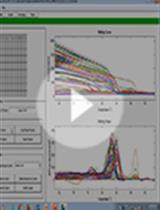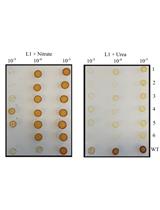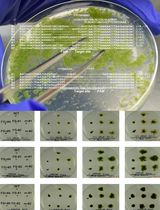- EN - English
- CN - 中文
CRISPR/Cas9 Gene Editing in the Marine Diatom Phaeodactylum tricornutum
海洋硅藻三角褐指藻中CRISPR / Cas9基因编辑技术
发布: 2017年08月05日第7卷第15期 DOI: 10.21769/BioProtoc.2442 浏览次数: 14527
评审: Dennis NürnbergVera Karolina SchoftAgnieszka Zienkiewicz
Abstract
The establishment of the CRISPR/Cas9 technology in diatoms (Hopes et al., 2016; Nymark et al., 2016) enables a simple, inexpensive and effective way of introducing targeted alterations in the genomic DNA of this highly important group of eukaryotic phytoplankton. Diatoms are of interest as model microorganisms in a variety of areas ranging from oceanography to materials science, in nano- and environmental biotechnology, and are presently being investigated as a source of renewable carbon-neutral fuel and chemicals. Here we present a detailed protocol of how to perform CRISPR/Cas9 gene editing of the marine diatom Phaeodactylum tricornutum, including: 1) insertion of guide RNA target site in the diatom optimized CRISPR/Cas9 vector (pKS diaCas9-sgRNA), 2) biolistic transformation for introduction of the pKS diaCas9-sgRNA plasmid to P. tricornutum cells and 3) a high resolution melting based PCR assay to screen for CRISPR/Cas9 induced mutations.
Keywords: CRISPR/Cas9 technology (CRISPR/Cas9技术)Background
The CRISPR/Cas9 system has proven to be a very efficient and successful genome editing system in a number of eukaryotic organisms, now also including microalgae (Hopes et al., 2016; Nymark et al., 2016; Shin et al., 2016). The CRISPR/Cas9 system includes a guide RNA (gRNA) and a nuclease called Cas9 (Sander and Joung, 2014). These two molecules form a complex where the gRNA directs the complex to the target of interest. The Cas9 nuclease induces double strand brakes at the target site that can be repaired by nonhomologous end joining (NHEJ) which can result in indel mutations, or via the homology-directed repair (HDR) pathway that can be exploited to create defined alterations of the DNA. The presented protocol is the first to describe a step-by-step procedure for applying the CRISPR/Cas9 system to create gene-targeted mutations (indels ranging from one to hundreds of nucleotides) in one of the main diatom model species, P. tricornutum.
Materials and Reagents
- Pipette tips, 1,000 µl (SARSTEDT, catalog number: 70.762.100 )
- Pipette tips, 200 µl (SARSTEDT, catalog number: 70.760.502 )
- Pipette tips, 20 µl (Biosphere® Tip 20 µl neutral) (SARSTEDT, catalog number: 70.1116.200 )
- Filter tips, 20 µl (Biosphere® Fil. Tip 20 µl neutral) (SARSTEDT, catalog number: 70.1116.210 )
- 24 or 48-cell multiwell cell culture plates, flat bottom, TC treated (VWR, catalog number: 734-2325 or 734-2326 )
- 1.5 ml tube
- Parafilm
- 50 ml centrifuge tube (SARSTEDT, catalog number: 62.547.254 )
- 0.2 µm sterile filter
- Macrocarriers (Bio-Rad Laboratories, catalog number: 1652335 )
- 1,550 psi rupture discs (Bio-Rad Laboratories, catalog number: 1652331 )
- Stopping screens (Bio-Rad Laboratories, catalog number: 1652336 )
- Phaeodactylum tricornutum cells (NCMA Bigelow Laboratory for Ocean Sciences, Bigelow, catalog number: CCMP2561 starter culture)
- Competent DH5α E.coli cells (‘home-made’ RbCl competent cells [efficiency ≥ 1.0 x 106 cfu/µg])
- pKS diaCas9-sgRNA plasmid (Addgene, catalog number: 74923 )
- pAF6 plasmid (Falciatore et al., 1999) containing the ShBle gene conferring resistance to zeocin
- BsaI-HF restriction endonuclease (New England Biolabs, catalog number: R3535S )
- Complementary oligos (24 nt) with 5’ TCGA and AAAC overhangs (for creation of the adapter for targeting the gene of interest). Custom DNA oligos can be ordered from Sigma-Aldrich
- Wizard® SV Gel and PCR Clean-Up Kit (Promega, catalog number: A9282 )
- T4 DNA ligase buffer (New England Biolabs, catalog number: M0202S )
- ExTaq DNA polymerase and buffer system (AH Diagnostics) (Takara Bio, catalog number: RR001A )
- QIAprep Spin Miniprep Kit (QIAGEN, catalog number: 27106 )
- 50% (v/v) seawater plates supplemented with f/2-Si, 1% (w/v) agar plates
- Tungsten M10 or M17 microcarriers (Bio-Rad Laboratories, catalog number: 1652266 or 1652267 )
- Calcium chloride dihydrate (CaCl2·2H2O) (Sigma-Aldrich, catalog number: C7902 )
- Spermidine (Sigma-Aldrich, catalog number: S2626 )
- 70% (v/v) and 100% EtOH
- 70% (v/v) isopropanol
- 50% (v/v) seawater plates supplemented with f/2-Si, 1% (w/v) agar plates, 100 µg/ml zeocin
- Zeocin (InvivoGen, catalog number: ant-zn-5p )
- TOPO® TA Cloning® Kit for Sequencing (Thermo Fisher Scientific, InvitrogenTM, catalog number: 450030 )
- LightCycler 480 High Resolution Melting Master Kit (Roche Molecular Systems, catalog number: 04909631001 )
- TritonTM X-100 (Sigma-Aldrich, catalog number: X100 )
- Trizma® base (Sigma-Aldrich, catalog number: T6066 )
- Ethylenediaminetetraacetate acid disodium salt (EDTA) (Sigma-Aldrich, catalog number: E5134 )
- Pancreatic peptone (VWR, catalog number: 26208.297 )
- Bacto yeast extract (BD, BactoTM, catalog number: 212750 )
- Bacteriological agar (VWR, catalog number: 84609.5000 )
- Sodium chloride (NaCl) (Merck, catalog number: 106404 )
- Lysis buffer (Buffer for lysis of P. tricornutum cells) (see Recipes)
- LB medium (see Recipes)
- LB agar plates (see Recipes) containing 100 µg/ml ampicillin
- f/2 growth medium with natural (or artificial) seawater (see Recipes) (Guillard, 1975)
Equipment
- NanoDrop ND-1000 or ND-2000 spectrophotometer (Thermo Fisher Scientific, Thermo ScientificTM, model: NanoDropTM 1000 or NanoDropTM 2000 )
- Heating block (Thermo Fisher Scientific, Thermo ScientificTM, catalog number: 88870005 )
- Water bath (Grant Instruments)
- Micropipettes (Eppendorf, model: Eppendorf Research® , variable volume)
- Table top centrifuges (Fisher Scientific, model: accuspinTM Micro 17R , catalog number: 13-100-676)
- Incubator shaker (Eppendorf, New BrunswickTM, model: Innova® 44 , catalog number: M1282-0002)
- Sterile bench (Thermo Fisher Scientific, Thermo ScientificTM, model: Holten Horizontal Laminar Airflow )
- PCR thermal cycler (Bio-Rad Laboratories, model: T100TM, catalog number: 1861096 )
- LightCycler® 96 Real-Time PCR system (Roche Molecular Systems, catalog number: 05815916001 )
- Biolistic PDS-1000/He Particle Delivery System (Bio-Rad Laboratories, catalog numbers: 165-2257 and 165-2250LEASE to 165-2255LEASE )
- Vortex
- Autoclave
- Refrigerator
Software
- LightCycler® 96 Software Version 1.1 (Roche Molecular Systems)
Procedure
文章信息
版权信息
© 2017 The Authors; exclusive licensee Bio-protocol LLC.
如何引用
Nymark, M., Sharma, A. K., Hafskjold, M. C. G., Sparstad, T., Bones, A. M. and Winge, P. (2017). CRISPR/Cas9 Gene Editing in the Marine Diatom Phaeodactylum tricornutum. Bio-protocol 7(15): e2442. DOI: 10.21769/BioProtoc.2442.
分类
微生物学 > 微生物遗传学 > 诱/突变
分子生物学 > DNA > 诱/突变
您对这篇实验方法有问题吗?
在此处发布您的问题,我们将邀请本文作者来回答。同时,我们会将您的问题发布到Bio-protocol Exchange,以便寻求社区成员的帮助。
Share
Bluesky
X
Copy link














